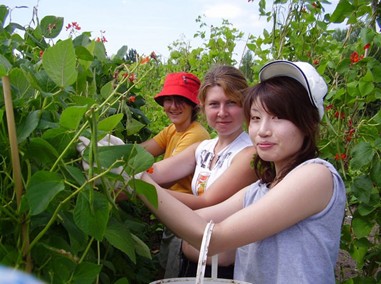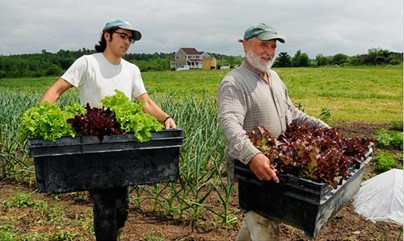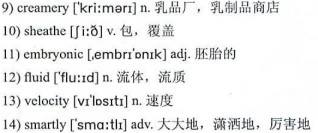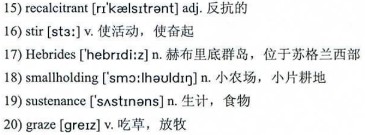 World Wide Opportunities on Organic Farms(简称WWOOF),即“全球有机农场体验”活动,起源于上世纪70年代的英国,其初衷是面向都市人推出一种“以工换食宿”的农村生活体验方式,而发达国家从上世纪70年代开始轰轰烈烈进行的“有机食品”运动也大大促进了WWOOF的发展。
World Wide Opportunities on Organic Farms(简称WWOOF),即“全球有机农场体验”活动,起源于上世纪70年代的英国,其初衷是面向都市人推出一种“以工换食宿”的农村生活体验方式,而发达国家从上世纪70年代开始轰轰烈烈进行的“有机食品”运动也大大促进了WWOOF的发展。
依据WWOOF的准则,旅人可以到参与WWOOF计划的有机农场干活,每天只需劳作4到6个小时就可赚取农场提供的免费食宿。由于参与WWOOF计划的农场不向旅人支付薪酬,所以安排的农活都比较轻松,大多为播种、除草、收割、施肥、砍柴、挤牛奶等。而工作结束后,旅人也有足够的时间到附近游玩。如今,WWOOF已演变为一种全世界范围内的集旅游、劳动体验及文化交流于一体的特殊旅行方式。全世界已有包括中国在内的60多个国家加入了WWOOF活动,详情可登陆WWOOF官方网站http://www.wwoof.org/查阅。
本期,小编节选了一位WWOOFer在英国两个有机农场体验农村生活后写下的游记,让我们赶紧一同来细细品味本文作者Scott和同伴坦尼娅在英国农场里度过的惬意时光吧!
文字难度:★★★
Earlier this summer I escaped my desk job to participate in an agricultural work exchange program called World Wide Opportunities on Organic Farms (WWOOF). Through WWOOF, my partner Tanya and I arranged to stay on two farms, one in England for three weeks and another on a remote Scottish island for ten days. Working on the farms, though 1)muddy and sometimes 2)strenuous, made for a wonderful break from the office.
Radford Mill in the hilly country near 3)Bath was our first farm. A large operation by organic standards, the 80 acre farm grows vegetables and raises sheep, cows, pigs, and chickens. Everything is rooted in the principles of organic agriculture. The farm plants a variety of crops, uses 4)manure to 5)replenish the soil, and applies no pesticides or fertilizers.
WWOOF volunteers work in exchange for room and board. Tanya and I were given a room on the second floor of the eighteenth century farmhouse. There were 11 other people living on the farm at the time we visited: three volunteers from Germany, six long-term workers from England, the farm manager, Susan, and her 5-year-old daughter. Besides the last two people everyone was in their twenties.
Although in many ways a throw back to the sixties—almost everyone at the farm is a contemporary hippie—Radford Mill is a serious little business. The farm sells its produce in a shop in nearby 6)Bristol and at a weekly farmers’ market.
The typical work day at Radford Mill starts around seven and lasts until around 3:00 pm. In a given day, I planted 7)seedlings, 8)strung peas, packed produce for sale, placed bird nets over the berries, weeded a few overgrown beds and put down manure along rows of young crops.
In addition to produce, the farm sells yogurt and soft cheeses. My favorite day on the farm was spent helping Susan make the yogurt in the small 9)creamery next to the cow shed.
这个夏初,我从办公桌前的工作逃离出来,参加了一个名为“全球有机农场体验”的农活交流体验活动。在这次活动中,我和同伴坦尼娅被安排到两个农场里劳作,一个在英格兰,为期3周;另一个在苏格兰一个偏僻的岛上,为期10天。在农场里劳作,尽管会弄得脏兮兮的,有时还很艰苦,却是从办公室工作中抽身,释放身心的妙方。
瑞德福·米尔农场位于靠近巴斯市的山地郊野,是我们的第一站。这个占地80英亩(即323744平方米)的农场全面按有机农场的标准来运作,里面种有蔬菜,养有羊、牛、猪和鸡。所有农畜产品都遵循有机农业的种植和养殖模式出产。农场里种有品种丰富的农作物,以有机肥料补充土地养分,决不使用杀虫剂和化学肥料。
“全球有机农场体验”活动的志愿者通过劳作换取免费食宿。我和坦尼娅被安排住进一栋建于18世纪的农舍二楼的一个房间。在我们拜访期间,还有另外11个人住在农场里:3个来自德国的志愿者,6个来自英格兰在这里打长工的人,还有农场负责人苏珊和她那5岁的女儿。除了最后提到的那两个人以外,其他人都是二十来岁。
尽管瑞德福·米尔在许多方面都处于上世纪60年代的景况——农场里的绝大多数人都是当代“嬉皮士”——这农场可是正儿八经的一盘小生意,其农产品会被拿到附近布里斯托尔市的一间商店里出售,另外还会在每周一次的农民市集里卖。
瑞德福·米尔农场里典型的工作时间从早上7点持续到下午3点。这一天里,我会种秧苗、抽掉豌豆两边的筋、把农产品包装好准备出售、在浆果上方覆盖一层防雀网、给一些杂草丛生的田地除草,还要为一垅垅的秧苗施肥。
除了出产农产品,农场也销售酸乳酪和软芝士。在农场里,我最喜欢的一天是在牛棚旁的那个乳品小作坊里帮苏珊做酸乳酪。

Nights on the farm were pretty quiet but one evening I came across Susan and a German volunteer Inken standing over an ewe trying to give birth two month’s past the lambing season. Susan instructed Inken on how to pull the lamb from its struggling mother. Inken pulled out a motionless body 10)sheathed in 11)embryonic12)fluid. I thought the lamb was dead, but Susan picked it up by the back legs and swung it in a circle. Having reached a considerable 13)velocity, she then bounced the poor creature 14)smartly against the ground several times. I thought she was putting the lamb out of its misery but the procedure turned out to be the traditional method of getting 15)recalcitrant new-born lambs to breathe. It worked as the lamb 16)stirred with a gasping breath and within an hour looked to be doing well.
Our original plans after Radford Mill were to rent a car and drive to our next stint as WWOOF volunteers. This changed when someone on the farm sold us an old car for $300. From Radford Mill in southern England we drove the car over 1000 miles to the Scottish highland town of Oban, and then took a ferry to the island of Tiree.
Tiree is the most westerly of the Inner 17)Hebrides, the chain of islands off the west coast of Scotland. The ferry took four hours to reach the flat island known by its early Celtic inhabitants as “the land below the waves”.
Our new host Elizabeth, a retired occupational therapist in her seventies, picked us up at the dock. Elizabeth calls her house and small plot of land by the water the Glebe House. In contrast to Radford Mill, Glebe House is a18)smallholding where most of the work is for19)sustenance rather than for commercial purposes. There is a one-acre walled garden and a flock of sheep that 20)graze by the sea.
Elizabeth gave us a top floor bedroom with windows looking out on the two-mile-wide Gott Bay. Coming into the room for the first time, Tanya looked out of the window and saw a pair of seals sunning themselves on the rocks.
As it was late June, we arrived after much of the garden work. Elizabeth however found some work for us to do. Her garden is built on a slope broken into 21)tiers. During the spring rains, one tier had begun to erode and fall into the next. Elizabeth asked us to build some sort of 22)retaining wall. The work day lasted no more than six hours, included a long lunch and frequent tea breaks, and left us with plenty of time and energy to explore the island afterward.
The flat, virtually treeless (the winter winds knock them down) island receives more sunlight than anywhere else in Britain. This might not sound impressive since Britain is known for gloomy weather, but Tiree is a very sunny place in summer.
Tiree, which has a year round population of 800 and a summer population of 2000, is crowded only by sheep. With so few people, Tiree lacks traffic, street lights, and the sort of background noise you get used to in urban places. Ten days on the island working in the walled garden relieved me of all the stress built up from my years spent in Washington, D.C.
The program saved us a good amount of money in room and board. We could not possibly have stayed in Britain that long otherwise. But what I liked even more was that the program provided us with something interesting to do. If learning about small farming interests you or if you just want to do some creative traveling around the world, throw some old clothes in a bag, put those boots on, and go “WWOOFing”.
农场的夜晚静悄悄的,但有天晚上,我偶然碰见苏珊和一个德国志愿者因肯跨在一头母羊上试图帮它接生,那时,产羊季已过了两个月。苏珊指导着因肯如何把小羊从挣扎不断的母体里拉扯出来。因肯拉出了一只一动不动的小羊,它满身是羊水胎液。我以为小羊死了,但苏珊抓着它的后腿,整只弄起绕圈甩动。达到一定速度后,她接着把那个可怜巴巴的小羊羔狠狠地往地上摔了好几次。我以为她是在为小羊羔实施“安乐死”,但原来这是帮助挣扎的新生羊羔顺畅呼吸的传统方法。小羊羔奋起喘息了一下,这方法管用,不到一个小时,小羊羔已经看上去很精神了。
我们原计划在瑞德福·米尔农场之行结束后租一辆车开到我们作为“全球有机农场体验”活动志愿者的下一站。后来瑞德福·米尔农场里有人以300美元的价格卖了辆旧车给我们,计划因此改变。我们从位于英格兰南部的瑞德福·米尔农场驱车1000英里(约1609.3公里),前往苏格兰高地小镇奥本,从那乘船前往泰里岛。
泰里岛位于内赫布里底群岛(苏格兰西海岸对面的岛群)的最西端。经过4个小时的船程,我们抵达了这一平坦的小岛,早期在这里的凯尔特居民曾称之为“海浪下的土地”。
我们的新主人伊丽莎白是个七十多岁已退休的职业理疗师。她在码头迎接我们。伊丽莎白将她的房子及水边的那小块地统称为“格里伯小屋”。相比瑞德福·米尔农场,格里伯小屋是个小农场,其大多农产品都用于维持生计而非用于销售获利。那里有一个用墙围起来占地一亩的花园,一群羊在海边吃着草。
伊丽莎白安排我们住进顶层的一间卧室,房间的窗朝向两英里(约3.2公里)宽的高特湾。第一次走进那间屋子,坦尼娅从窗口望出去,就看见一对海豹在岩石上晒太阳。
由于我们到达那里时已是6月底,花园里的大部分农活已完成。但伊丽莎白还是给我们找了些事做。她的花园建在一个修成好几级的斜坡上。每到春雨时节,雨水渗蚀,斜坡会一层层往下陷。伊丽莎白让我们建一堵挡土墙。每个工作日里,工作时间都不超过6小时,其中还包括一顿时间较长的午餐及数次喝茶休息时间。于是劳作结束后,我们有充足的时间和精力去探索整个岛。
这个平坦且近乎没有树(冬季里的风把它们刮倒了)的岛上,阳光比英国任何别的地方都要多。这听起来好像也没什么,因为英国的阴郁天气是出了名的,但泰里岛在夏天却是阳光灿烂。
泰里岛全年长住人口约为800人,到了夏季,人口会有2000人,这里最多的就是羊群。由于人口极少,泰里无甚车流交通可言,这里没什么交通灯,也没有你在城市里习惯了的那种噪音。在岛上那围墙花园里的10天劳作除去了我在华盛顿这些年里积聚的所有压力。
这个活动为我们节省了一大笔食宿开支。不然,我们不可能在英国呆上这么多天。但我更喜欢这个活动能给我们一些有趣的事情做。如果你对了解小农场感兴趣,或者只是想进行一次具有创意的环球之旅,那就扔几件旧衣服进包里,穿上那对靴子,开始“全球有机农场体验”吧。




![]()
![]()
